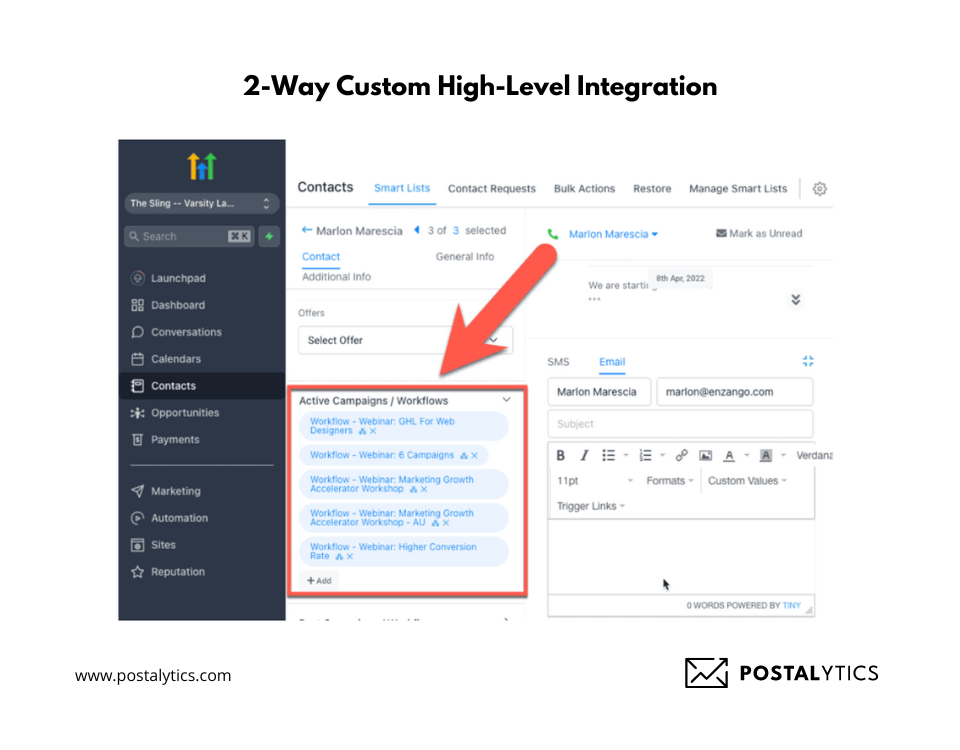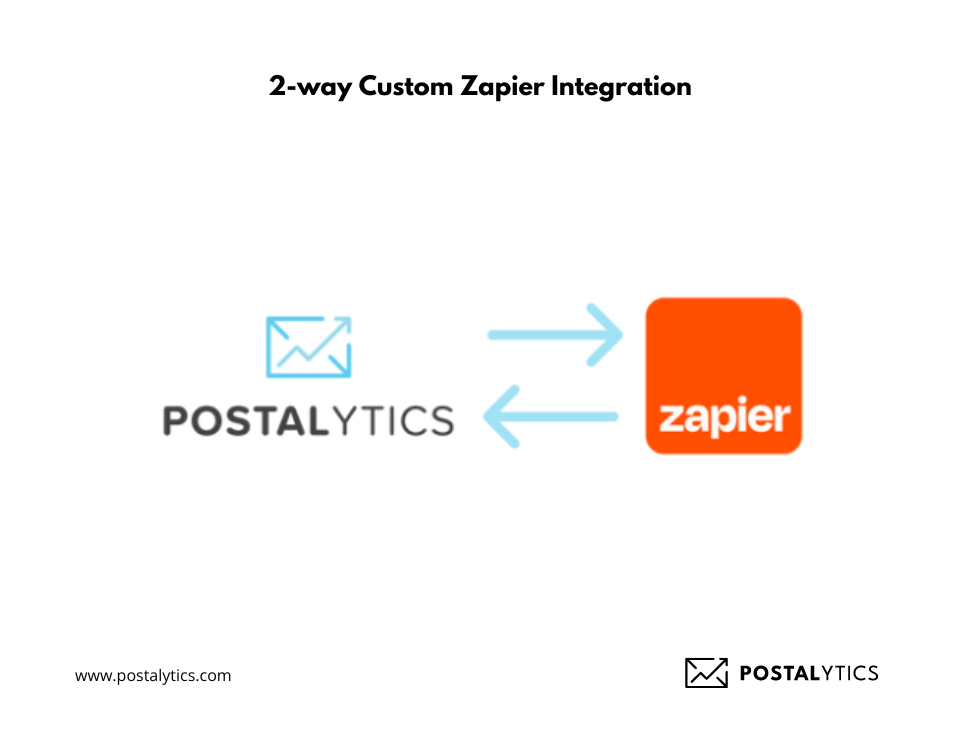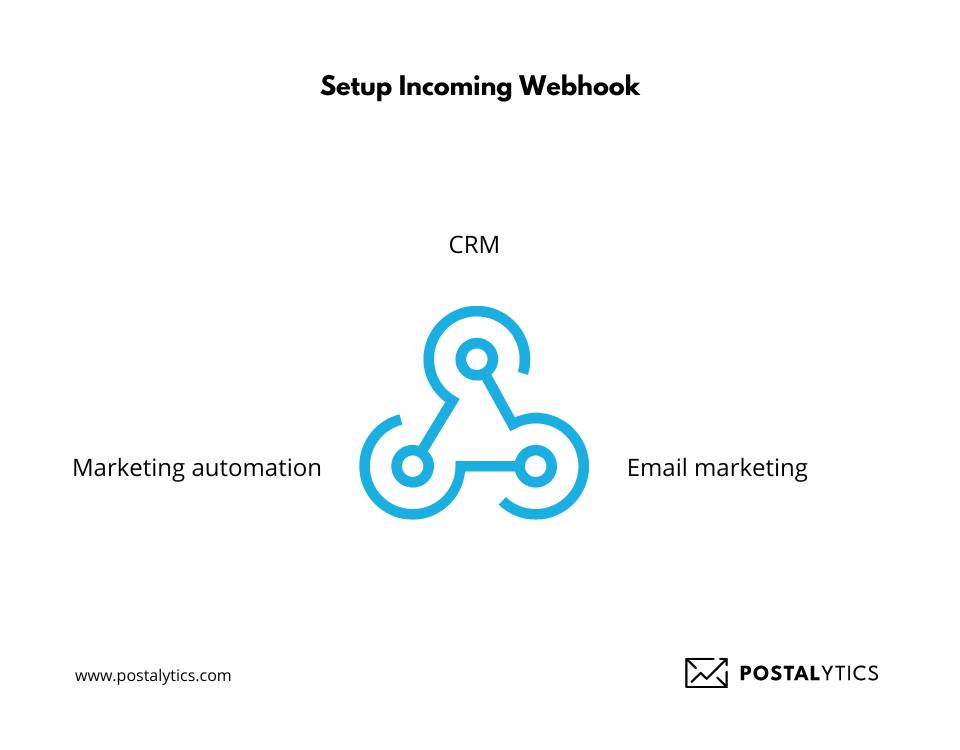![[POSTALYTICS] The Complete Guide to Direct Mail Integration Tools](https://www.postalytics.com/wp-content/uploads/2023/04/POSTALYTICS-The-Complete-Guide-to-Direct-Mail-Integration-Tools-1024x536.png)
Marketing tools are designed to make your marketing efforts easier. But when using multiple tools, things quickly get complicated, processes take longer, and the results are messy.
You need marketing automation software like Postalytics, which offers direct mail integration tools to ensure this doesn’t happen with your direct mail campaigns. These integrations let you easily create campaigns, import your mailing lists, provide personalization by pairing them with your CRM tools, and much more.
Learn more about marketing automation integration and how it can benefit your direct mail strategies in our handy guide.
What We’ll Cover:
- What Is Marketing Automation Integration?
- What Is Direct Mail Automation Integration?
- Why Is Direct Mail Automation Integration Important?
- Integration Tools for Direct Mail Marketing
- #1 2-Way Custom HubSpot Integration
- #2 2-Way Custom Salesforce Integration
- #3 2-Way Custom ActiveCampaign Integration
- #4 2-way Custom Zoho Integration
- #5 2-Way Custom High-Level Integration
- #6 2-Way Custom Klaviyo Integration
- #7 Custom Keap/Infusionsoft Integration
- #8 2-way Custom Zapier Integration
- #9 Incoming Webhook Integration
- #10 Outgoing Webhook Integration
- #11 Direct Mail API
- #12 Log Viewer – Events, Outgoing webhooks, Incoming API & Triggered Drip Logs
- #13 Iframe/Express Windows API integration
- Tips to Maximize the Automation Integration Relationship
- Final Thoughts
What Is Marketing Automation Integration?
Marketing automation integration allows a marketing automation platform to connects with other tools and platforms. This happens through APIs (Application Programming Interfaces), allowing data sharing between both platforms so they remain in sync.
Here’s an example to understand this integration better. Your marketing and sales teams must often access the same data to engage and nurture leads. When a lead is generated through a marketing automation platform like Marketo, with integration, this data automatically gets reflected in your customer relationship management platform, like HubSpot.
This integration also works vice versa and thus saves a lot of manual work that goes into updating records and creating data from scratch.
What Is Direct Mail Automation Integration?
Direct mail automation integration allows businesses and agencies to leverage the power of multiple tools and bring them together to automate and streamline your direct mail campaigns.
Additionally, you can use these integrations to combine your direct mail initiatives with other online ones. For example, with Postalytics, you can include pURLs on your direct mailers. When your clients use these URLs, they can be directed to the landing pages, and all that information can then be tracked and stored in your marketing tools.
Other than that, you can share data, automate triggered mail with certain actions, send email non-email responders automated postcards and more with these integrations in marketing automation platforms.
Why Is Direct Mail Automation Integration Important?
You can do a lot of things with direct mail automation integration. Here are three key reasons why you should adopt it today:
Minimized human errors
When you remove manual activities from your processes, there are fewer chances of errors and inconsistencies. For example, data issues will be less likely to crop up when you import your customer list from your CRM for direct mail campaigns instead of typing that information. This significantly impacts your costs (for example, avoids mail getting delivered to the wrong address because of a typing mistake) and improves customer experience (for example, avoids the customer’s name being spelled wrong).
Boosts staff productivity
When you automate time-consuming and low-value activities, your team can work on meaningful tasks that deliver value to the team and customers. This boosts their motivation and productivity. With this increased productivity, they can better support clients, resulting in better customer experiences and possibly retention.
Quick integration implementation
Instead of relying on developers and engineers to help you integrate your most-used tools, direct mail automation integration allows you to integrate with another app in a few minutes or even automatically. This helps your team leverage the power of multiple tools and create workflows that make the production and deployment of your direct mail marketing campaigns seamless.
Integration Tools for Direct Mail Marketing
Direct mail marketing automation tool provides many integration functionalities you can use. Here are the top ones Postalytics offers:
#1 2-Way Custom HubSpot Integration
Postalytics offers 2-way HubSpot integration that allows you to send personalized postcards and letters. You can use HubSpot contacts, lists and workflows to send tracked marketing direct mails in minutes. Triggered drip campaigns can be automated with this integration.
Other than that, with USPS intelligent mail barcode delivery scans, each mailpiece can be monitored, and records can be continually updated in HubSpot.
#2 2-Way Custom Salesforce Integration
With Salesforce CRM integration, you can easily create mailing lists and use the data in Salesforce leads, contacts, campaigns, accounts, and workflows. You can track everything with Salesforce integration if you’re running multi-channel marketing initiatives.
You can even trigger direct mail based on certain actions or workflows like onboarding, abandoned cart, re-engagement, upcoming purchase reminders, etc. This helps you stay on top of things and let automation trigger direct mail irrespective of the volume.
#3 2-Way Custom ActiveCampaign Integration
Postalytics’ integration with ActiveCampaign lets you capture mail delivery and response data to trigger multi-channel marketing easily. It also allows your team to use the latest ActiveCampaign CXApps technology to help stand out from competitors.
Personalization can be done for each recipient with data from ActiveCampaign, and you can set up triggered direct mail based on certain actions via this integration. You can even import your designs without the usual back-and-forth.
#4 2-way Custom Zoho Integration
With Zoho CRM direct mail integration, your team can send direct mail to a set of new contact entries, add direct mail tracking data to each CRM record, copy and re-use a direct mail campaign, and automate campaigns based on Zoho workflows.
This integration even allows you to send direct mail to your entire contact list with one click
#5 2-Way Custom High-Level Integration
Fully automated HighLevel direct mail integration lets you send triggered and personalized direct mail to your leads and customers throughout the customer journey and marketing funnel.
You can even track your direct mail delivery status within the tool and track who responded to the mailers. With pURLs, you can have personalized landing pages that take no time to make and has variable logic and data implemented so the recipient can get a unique experience.

#6 2-Way Custom Klaviyo Integration
As part of your customer experience strategy, the direct mail integration with Klaviyo makes sending personalized postcards and letters easy and increases customer satisfaction.
Instead of exporting .CSV files that take a lot of time, you can import lists directly from Klaviyo lists and segments while your addresses get validated. You can even track mail delivery and response data that automatically gets updated in Klaviyo.
#7 Custom Keap/Infusionsoft Integration
You can send tracked direct mail using Keap/Infusionsoft automation that works with Postalytics triggered drip campaigns. You can even set rules and conditions for these campaigns to provide a better and more personalized touch.
Multi-touch and multi-channel campaigns can also be set up to increase response rates, like sending a thank you letter and email to all new customers.
#8 2-way Custom Zapier Integration
With Zapier integration, you can automate many direct mail activities and even streamline your workflows with different tools using Zaps. Postalytics has developed an “action” and a “trigger” to work with CRM, email marketing, marketing automation, and other tools that work with Zapier. These actions can be used to send any supported direct mail format and can also be a part of a multi-step workflow within Zapier.

#9 Incoming Webhook Integration
Postalytics can send direct mail to contacts that are triggered via webhook URLs. This becomes possible because we created a method that processes authenticated and properly formed JSON calls and generates direct mail.
This enables any third-party tool to act as a data source and workflow engine to trigger mail to be printed, sent, and tracked via Postalytics. To use this integration, you must first create an Incoming webhook-triggered drip campaign.

#10 Outgoing Webhook Integration
You can set up different endpoints for each campaign with outgoing webhook integration. Select “Webhooks” from the drop-down menu in your Postalytics username to set these webhooks.
Over here, you can select the different webhooks you want to be notified about.
The endpoint URL in this will be the receiving application that will consume the webhook we send to you. You can click “Update” once you’re done, and the changes will be applied.
#11 Direct Mail API
APIs have become an easy way for businesses to weave together applications in ways that best suit your needs. Postalytics provides a robust, modern direct mailing API to help you integrate the direct mail automation tools with your applications and workflows.
This helps you send automated postcards and letters without figuring out how to construct UI-intensive functions such as campaign wizards, template building, and direct mail analytics presentation.
#12 Log Viewer – Events, Outgoing webhooks, Incoming API & Triggered Drip Logs
Logs help users and developers understand exactly what is happening behind the scenes in Postalytics. These logs are filled with “events” that occur in an automated tool while creating, mailing, and tracking direct mail campaigns.
The Postalytics log viewer helps you look at the details surrounding these events. This tool is often used when integrating Postalytics with another system via the API or Postalytics integrations.
#13 Iframe/Express Windows API integration
Express Windows allows you to use the Postalytics UI in your app. Your account can do a number of things like build, proof, and save postcard and letter templates, view detailed campaign dashboards and analytics, import and manage lists, and run the campaign wizards to generate direct mail campaigns.
Tips to Maximize the Automation Integration Relationship
By integrating your tools strategically and effectively, you can unlock many benefits. Here are five tips on making the most out of your automation integrations.
Use personalized marketing and sales tactics
The main benefit of using integrations is that you can personalize your marketing and sales strategies. For example, your marketing team can draw in data from your CRM. This makes your direct mailers more targeted and effective. You can even determine the lead’s stage and use those actions to trigger campaigns.
To make the most of these integrations, you can create a personalization plan and then find ways to make this process seamless.
Create precise lead-scoring criteria
Not all leads may be worth sending direct mail to. One method to determine which leads make the cut is lead scoring. These lead scoring criteria depend on many factors, such as how they came into your pipeline, their actions, their company size, etc.
Setting these criteria properly can help you create proper response plans and campaigns that result in high conversions.
Track post-SQL activity
A lead may have transitioned to a SQL (Sales Qualified Lead) from an MQL (Marketing Qualified Lead). In such a scenario, how your sales team communicates with them or takes further actions can make all the difference.
You can set up triggers that alert your sales team with the relevant information they need to take things forward.
Remove duplicate instances
Duplication can lead to mixed messaging in your outbound communication, false reporting, and sometimes compliance issues. To avoid this, you need sales and marketing teams to review accounts for duplicate records regularly and then delete them.
While integrating, ensure you don’t have multiple workflows for the same task and unnecessarily increase the time required to fulfill one activity.
Prioritize agility in integration
After integration, your teams will likely see a boost in productivity and performance because they will now find it easy to complete tasks quickly.
To maintain the same standard, you need to prioritize agility in integration. One way to do that is to configure your integrations so that it does not require heavy coding knowledge. This way, you can easily make changes whenever required.
Final Thoughts
Direct mail marketing automation tools can be a super-quick and easy way to leverage marketing automation integration in different workflows and activities. This automation can help you create, send, and track direct mail campaigns while tightening up processes and minimizing the risk of costly errors.
Using Postalytics, you can access many integration functionalities with the top CRM tools like HubSpot and Salesforce. On top of that, you can even build your integrations with other tools without requiring heavy coding knowledge.
Get Your free account today and render your direct mail campaigns seamless.
About the Author

Dennis Kelly
Dennis Kelly is CEO and co-founder of Postalytics. Dennis joined Boingnet, the predecessor to Postalytics, in 2013. Boingnet was focused on providing print and direct mail marketing service providers the ability to add digital marketing channels to their direct mail campaigns. Postalytics is Dennis’ 6th startup. He has been involved in starting and growing early-stage technology ventures for over 30 years and has held senior management roles at a diverse set of large technology firms including Computer Associates, Palm Inc. and Achieve Healthcare Information Systems.
